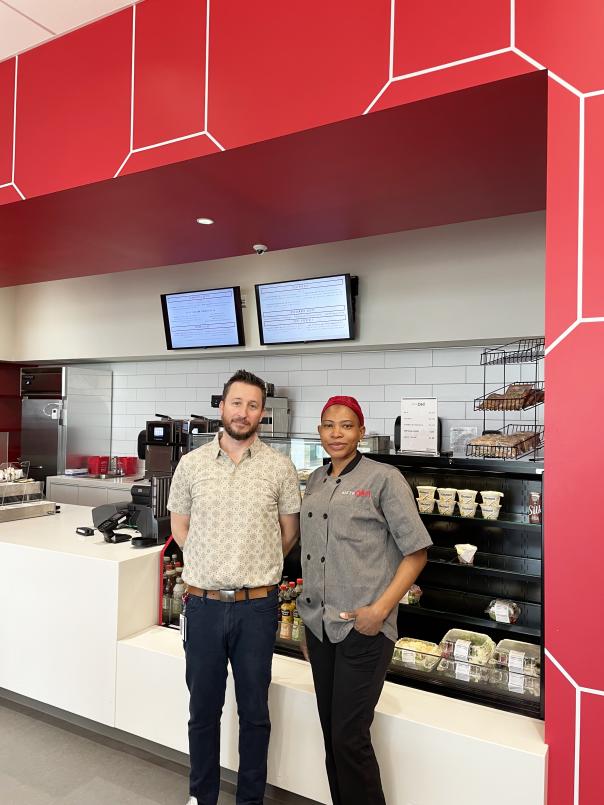
The Ohio State University Wexner Medical Center in Columbus, Ohio, has found a solution to feeding people in its far-flung buildings. It is opening BistrOH! and BistrOH! To Go retail operations, typically on the ground floor and ideally near the entrance so they’re easily visible to patients and customers.
The medical centre is continuously expanding, largely into different buildings, mostly within five miles of the main hospital but a couple of BistrOH! locations are 18 miles away.
BistrOH! sites are open 6am to 8pm, while the To Go locations typically operate between 7am and 3pm. Breakfast and lunch are the busiest time. Breakfast includes dishes like quiche lorraine and Belgian waffles; lunch and dinner offerings range from fish tacos and spring noodle bowl to barbecue pork loin and white bean chilli.
Made-to-order sandwiches are the biggest seller. There are several stations including the grill; salads; grain bowls; a stone hearth; a chef’s table; a soup station; and an action station (which runs on a one-month rotation, featuring a variety of ethnic food and dining preferences such as vegan).
But each location serves slightly different food. If there are no other dining options nearby, the BistrOH! needs to have a more substantial menu.
“Our menu changes seasonally,” says Julie Meddles, MS, RDN, LD, director of health system nutrition services and gift shops. “But if there are no other food offerings nearby we have to change it more frequently, and offer more selection.”
Meddles tries to keep the menus the same at the locations for simplicity and says innovative chefs can really appeal to customers if they get to know them and tailor menus to what they’re looking for.
At some locations, she points out, the menu is based on speed of service due to the needs of customers. “For areas that require quicker service, we intentionally create dishes with no more than five touch points,”
Meddles says. “In locations where speed is not at the forefront, we’ll go up to 11 touch points on a dish.”
Patients, their visitors and medical centre staff use BistrOH!, but employees make up the bulk of customers, says Meddles.
Most people take away food from BistrOH, ‘due to preference of eating in their own break areas’ and the To Go food selections are conducive to being taken away but don’t centre on that concept.
Considerations of new sites
The BistrOH! sites all feature a red logo outside to create strong branding. If they’re not located by the entrance to a building, a red wall guides customers to them.
Currently there are 16 BistrOH! sites and more are coming — a new 820-bed hospital will have three retail operations when it opens in early 2026. Later that same year there will be a BistrOH! To Go at an outpatient site.
When Meddles considers whether to add a BistrOH! to a new outbuilding, she calculates how many staff there are likely to be, as well as patients and guests, and she analyses other food options nearby.
She also wants to know if the operation will be subsidised so she knows if the goal of the site is to make revenue or simply to cover costs, she explains. And she calculates how much money it’s likely to make; and how much space is available for it. “It’s really important that there’s enough space for a BistrOH! to grow,” she points out.
Typically these locations see good volumes, Meddles says. “If we have at least 500 staff at this site, and a healthy volume of patients and visitors, it keeps volumes high.”
BistrOH! food is made in the medical centre’s central production kitchen then sent to the satellite sites via refrigerated truck. At the locations dishes are reheated in the combi ovens, and given a finishing touch to provide a made-from-scratch feel.
To ensure the food is in excellent condition when it’s served, the catering team puts all food through rigorous testing and continual quality control audits. And, since it’s all finished at the point of sale location, they’re ‘ensuring we are offering the freshest quality products’, says Meddles, which ‘maximizes quality and control [as well as] continuity of product across the health system’.
This keeps food costs down since sites only finish and use the amount they need, then save anything not used and not heated to use within the appropriate time frames. This also allows the foodservice department to control how much is distributed to each site, Meddles explains, ‘because we can produce based on volume and historical usage and data’.
Equipment at the BistrOH! locations is minimal because they were designed ‘for maximum output to run with minimal staff’, says Meddles. Around 90% of the food is heated in high speed combi ovens, which don’t require hoods, which keeps construction costs down.
Combi ovens are also very flexible, which is essential for an often-changing menu. The kitchens also need small under-counter dishwashers, hand wash sinks, a grease trap, backflow prevention/air gap and water that’s sufficiently hot, so adequate plumbing is always required. Some locations also have high speed blenders.
Technology is also vital, including a mobile app for ordering, says Meddles. Each BistrOH! has a pick-up area for these orders. Newer BistrOH! locations feature secure, ambient temperature food lockers within their design. In older spaces, the catering team retrofits pick-up locations as warranted by the volume of pick-up orders. These are ideally in easy sight lines of staff in that location, Meddles says.
The addition and expansion of BistrOH! locations at the medical centre has allowed the catering staff to continue to focus on dining on its main campus, while increasing revenue and its customer base further afield.